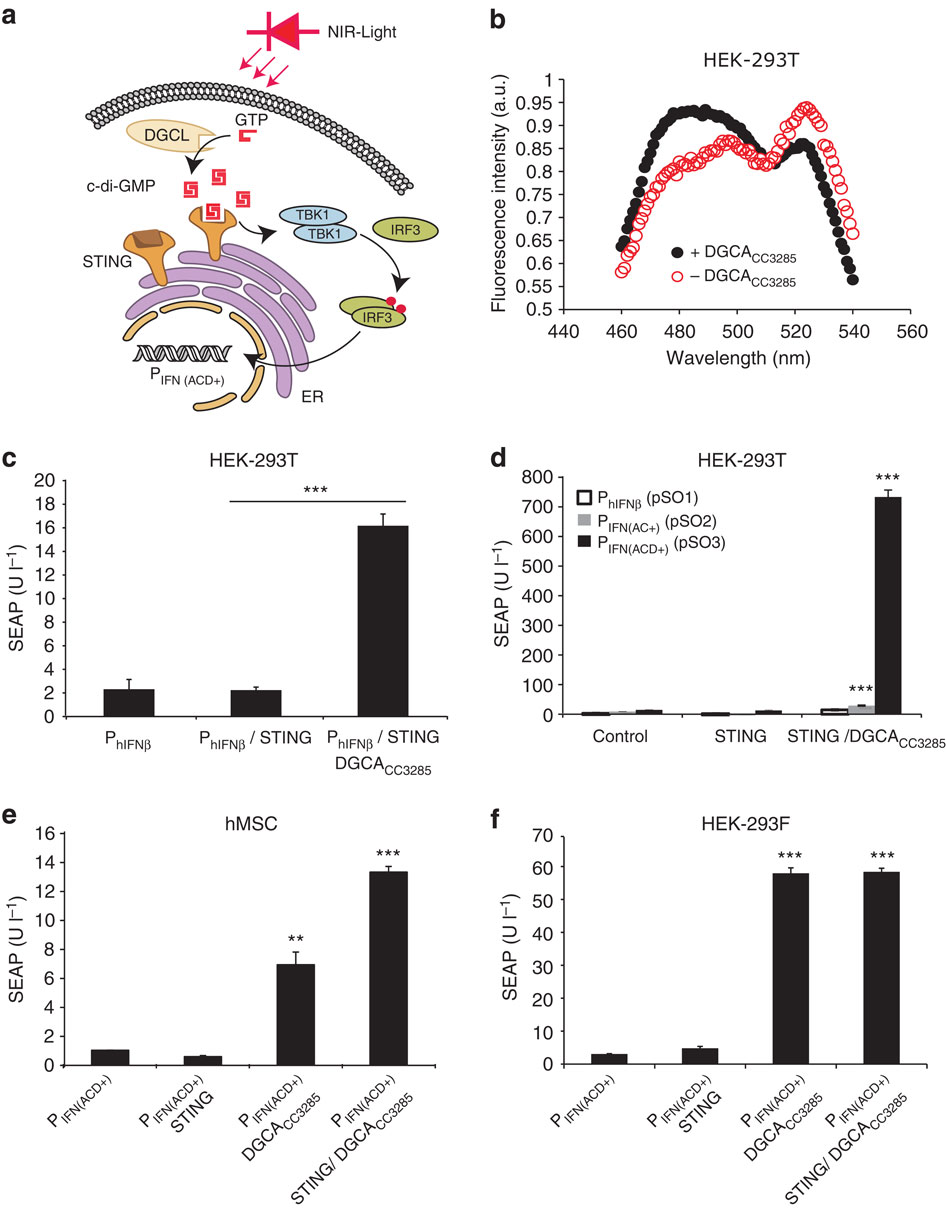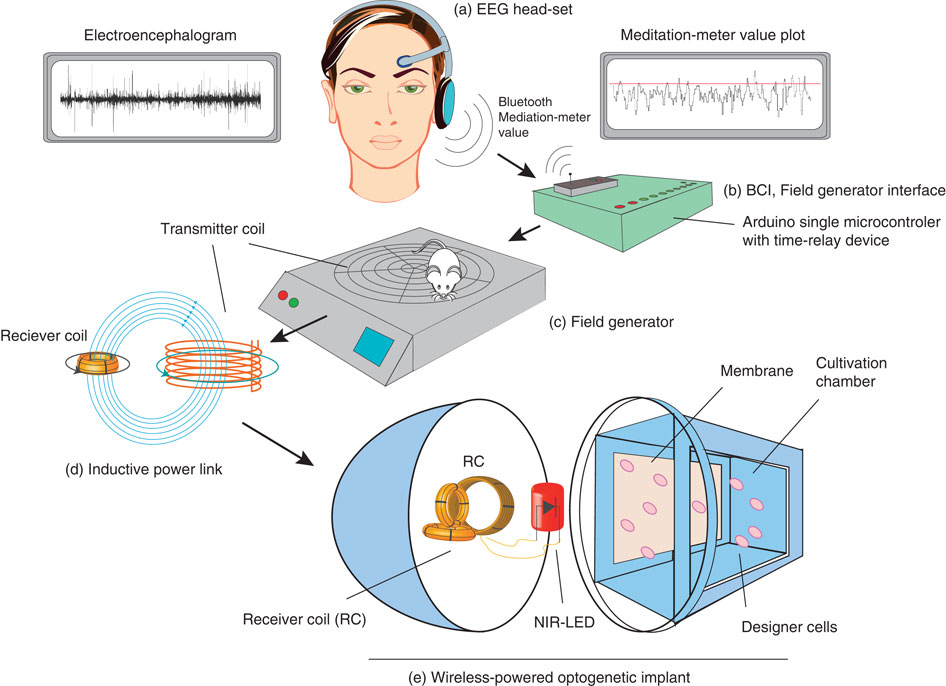
Synthetic devices for traceless remote control of gene expression may provide new treatment opportunities in future gene- and cell-based therapies. Here we report the design of a synthetic mind-controlled gene switch that enables human brain activities and mental states to wirelessly programme the transgene expression in human cells. An electroencephalography (EEG)-based brain–computer interface (BCI) processing mental state-specific brain waves programs an inductively linked wireless-powered optogenetic implant containing designer cells engineered for near-infrared (NIR) light-adjustable expression of the human glycoprotein SEAP (secreted alkaline phosphatase). The synthetic optogenetic signalling pathway interfacing the BCI with target gene expression consists of an engineered NIR light-activated bacterial diguanylate cyclase (DGCL) producing the orthogonal second messenger cyclic diguanosine monophosphate (c-di-GMP), which triggers the stimulator of interferon genes (STING)-dependent induction of synthetic interferon-βpromoters. Humans generating different mental states (biofeedback control, concentration, meditation) can differentially control SEAP production of the designer cells in culture and of subcutaneous wireless-powered optogenetic implants in mice.
Figure 1: Synthetic mammalian c-di-GMP-based second messenger pathway.
 (a) Schematic representation of the synthetic mammalian optogenetic signalling pathway. NIR light activates an engineered light-dependent bacterial phytochrome-associated DGCL, which converts GTP to the orthogonal second messenger cyclic diguanylate monophosphate (c-di-GMP). c-di-GMP binds and activates STING at the endoplasmic reticulum (ER) and specifies tank-binding kinase 1 (TBK1)-mediated phosphorylation of IRF3 (red dots). Phosphorylated IRF3 translocates to the nucleus, binds IRF3-specific operators and induces the optimized type-1 interferon promoters (PIFN(ACD+)). (b) FRET-based detection of c-di-GMP in HEK-293T cells containing the FRET biosensor plasmid pKZY81 (PSV40-mYPet-YcgR-mCYPet-pA) (co)-transfected with or without the DGCACC3285-expression vector pZKY121 (PSV40-DGCACC3285-pA). After excitation at 425 nm, FRET emission was scanned from 460 to 560 nm at 2-nm intervals. (c) c-di-GMP-based activation of STING-mediated induction of the hIFN-β promoter (PhIFNß). A total of 5 × 105 HEK-293T cells were (co)-transfected with different combinations of the constitutive Caulobacter crescentus DGCA (DGCACC3285) expression vector pZKY121 (PSV40-DGCACC3285-pA), the constitutive STING expression vector pSTING (PhCMV-STING-pA) and pSO1 (PhIFNß-SEAP-pA) to encode the human placental secreted alkaline phosphatase (SEAP) driven by the hIFN-β promoter (PhIFNß). SEAP expression was profiled in the culture supernatant after 48 h. HEK-293T cells require ectopic expression of STING to complement the corresponding endogenous mammalian pathway. (d) Comparative performance analysis of PhIFNß variants (PhIFNß, PIFN(AC+), PIFN(ACD+)). A total of 1 × 106 HEK-293T cells were co-transfected with the DGCACC3285-expression vector pKZY121, pSTING and pSO1 (PhIFNß-SEAP-pA), pSO2 (PIFN(AC+)-SEAP-pA) or pSO3 (PIFN(ACD+)-SEAP-pA), and SEAP levels were quantified in the culture supernatant after 48 h. Control populations were transfected without pKZY121 or without pKZY121 and pSTING. (e,f) Validation of the synthetic mammalian c-di-GMP-based second messenger pathway in human stem cells (hMSCs; e) and HEK-293T-derived serum-free suspension cultures (HEK-293F; f). A total of 5 × 104 hMSCs or HEK-293F cells were (co)-transfected with combinations of the DGCACC3285-expression vector pZKY121 (PSV40-DGCACC3285-pA), the STING expression vector pSTING (PhCMV-STING-pA) and pSO3 (PIFN(ACD+)-SEAP-pA). SEAP production was assessed in the culture supernatant after 48 h. Data are mean±s.d.; statistics by two-tailed t-test; n=6, triplicate experiments, **P<0.01, ***P<0.001.<>
(a) Schematic representation of the synthetic mammalian optogenetic signalling pathway. NIR light activates an engineered light-dependent bacterial phytochrome-associated DGCL, which converts GTP to the orthogonal second messenger cyclic diguanylate monophosphate (c-di-GMP). c-di-GMP binds and activates STING at the endoplasmic reticulum (ER) and specifies tank-binding kinase 1 (TBK1)-mediated phosphorylation of IRF3 (red dots). Phosphorylated IRF3 translocates to the nucleus, binds IRF3-specific operators and induces the optimized type-1 interferon promoters (PIFN(ACD+)). (b) FRET-based detection of c-di-GMP in HEK-293T cells containing the FRET biosensor plasmid pKZY81 (PSV40-mYPet-YcgR-mCYPet-pA) (co)-transfected with or without the DGCACC3285-expression vector pZKY121 (PSV40-DGCACC3285-pA). After excitation at 425 nm, FRET emission was scanned from 460 to 560 nm at 2-nm intervals. (c) c-di-GMP-based activation of STING-mediated induction of the hIFN-β promoter (PhIFNß). A total of 5 × 105 HEK-293T cells were (co)-transfected with different combinations of the constitutive Caulobacter crescentus DGCA (DGCACC3285) expression vector pZKY121 (PSV40-DGCACC3285-pA), the constitutive STING expression vector pSTING (PhCMV-STING-pA) and pSO1 (PhIFNß-SEAP-pA) to encode the human placental secreted alkaline phosphatase (SEAP) driven by the hIFN-β promoter (PhIFNß). SEAP expression was profiled in the culture supernatant after 48 h. HEK-293T cells require ectopic expression of STING to complement the corresponding endogenous mammalian pathway. (d) Comparative performance analysis of PhIFNß variants (PhIFNß, PIFN(AC+), PIFN(ACD+)). A total of 1 × 106 HEK-293T cells were co-transfected with the DGCACC3285-expression vector pKZY121, pSTING and pSO1 (PhIFNß-SEAP-pA), pSO2 (PIFN(AC+)-SEAP-pA) or pSO3 (PIFN(ACD+)-SEAP-pA), and SEAP levels were quantified in the culture supernatant after 48 h. Control populations were transfected without pKZY121 or without pKZY121 and pSTING. (e,f) Validation of the synthetic mammalian c-di-GMP-based second messenger pathway in human stem cells (hMSCs; e) and HEK-293T-derived serum-free suspension cultures (HEK-293F; f). A total of 5 × 104 hMSCs or HEK-293F cells were (co)-transfected with combinations of the DGCACC3285-expression vector pZKY121 (PSV40-DGCACC3285-pA), the STING expression vector pSTING (PhCMV-STING-pA) and pSO3 (PIFN(ACD+)-SEAP-pA). SEAP production was assessed in the culture supernatant after 48 h. Data are mean±s.d.; statistics by two-tailed t-test; n=6, triplicate experiments, **P<0.01, ***P<0.001.<>
Figure 2: Schematic representation of mind-controlled transgene expression.

The mind-controlled transgene expression device consisted of (a) an EEG headset that captured brain-wave activities (the encephalogram), identified mental state-specific electrical patterns (biofeedback, concentration, meditation) and processed discrete meditation-meter values (0–100; meditation-meter value plot), which were transmitted via Bluetooth to (b) the Arduino single-board microcontroller with a time-relay device and switching the (c) field generator ON and OFF. This BCI (a–c) controlled (d) the TC (c,d) of the field generator, which inductively coupled with the (d,e) receiver coil (RC) of the (e) wireless-powered optogenetic implant. (e) The NIR light LED illuminated the culture chamber of the wireless-powered optogenetic implant and programmed the designer cells to produce SEAP, which diffused through the semi-permeable membrane. The blood SEAP levels of mice with subcutaneous wireless-powered optogenetic implants containing designer cells that were freely moving on the field generator could be modulated by the human subject’s mindset in a wireless, remote-controlled manner. (See Supplementary Fig. 5 for a schematic of the electronic components).
